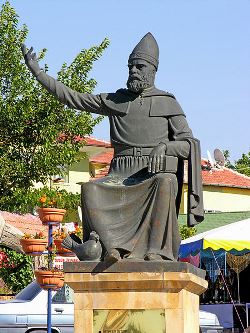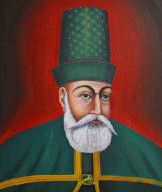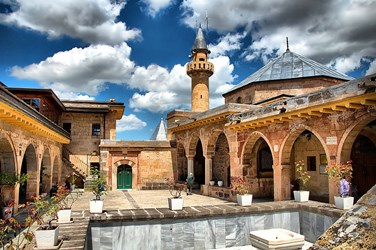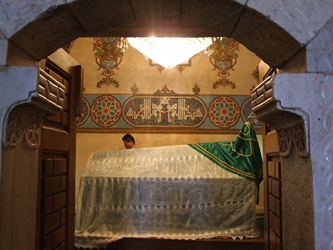Hacibektaş Town - Centre of Bektashi sect of Islam
Hacibektas (pron. Hajibektash) town is located in 40 minute drive distance from Goreme, town. The place is the centre of Bektashi sect of Islam founded by the great 13th century philosopher Haji Bektashi Veli.
One can see the dervish dergah (lodge), today a museum, cilehane (suffering house), bestashlar (five stones) and a cemevi (an alevi temple) in Hacibektas. If your visit is scheduled for August, you will be able to watch the commemoration ceremony, and get an idea of the living traditions of the order followers. Hacibektas is the sacred centre of Alevi Islam, and annually, on 16th, 17th and 18th of August, tens of thousands of people flock here, and not just from Turkey, but from Bulgaria, Albania and other Balkan countries.
 Haji Bektashi Veli, united the Christian residents of Anatolia and Turkoman migrants with their educational and developmental activities and played an important role in the formation of cultural unity and central authority in Anatolia. Some holy men migrated to Anatolia, settled on mountains and empty crossroads and opened dervish lodges there. These institutions settled on empty land gradually became centres for culture, development and religious thought. In this manner, religious congregations spread everywhere, rules of morals, good breeding, attitudes and beliefs reached a high standard, knowledge and science were both produced and spread in these centres. The administration encouraged such holy men to settle in villages, and their educational activities gave them some privileges. As a result, even in the most desolate places in Anatolia, dervish lodges emerged, and with the effect of the education they provided, a common cultural structure began to form. Haji Bektashi Veli, united the Christian residents of Anatolia and Turkoman migrants with their educational and developmental activities and played an important role in the formation of cultural unity and central authority in Anatolia. Some holy men migrated to Anatolia, settled on mountains and empty crossroads and opened dervish lodges there. These institutions settled on empty land gradually became centres for culture, development and religious thought. In this manner, religious congregations spread everywhere, rules of morals, good breeding, attitudes and beliefs reached a high standard, knowledge and science were both produced and spread in these centres. The administration encouraged such holy men to settle in villages, and their educational activities gave them some privileges. As a result, even in the most desolate places in Anatolia, dervish lodges emerged, and with the effect of the education they provided, a common cultural structure began to form.
Haji Bektashi Veli was one of those figures.
At that time, Anatolia was under Mongol occupation, there was a severe social and economic crisis and fighting for political power. In that difficult climate, Haji Bektashi Veli settled in Sulucakarahoyuk, developed his philosophy and began to teach his students. His tolerance and human love based philosophy reached many people, and were taken up by them in the important centre of Christianity of Cappadocia.
HACI BEKTAS-I VELI (HAJI BEKTASHI VELI)
Haji Bektash Veli was an Alevi Muslim mystic, Sayyid, humanist and philosopher, who lived and taught from approximately 1209 to 1271 in Anatolia. He is revered among Alevis for an Islamic understanding that is esoteric (spiritual), rational, progressive and humanistic. Alevi and Bektashi Muslims believe the path of Haji Bektas is the path of Ali-ibn Abu Talib, since Ali was the source of Bektas's teachings. His original name was Sayyeed Muhammad ibn Sayyeed Ebraheem Ata. He was one of the figures who flourished in the Sultanate of Rum and had an important influence on the Turkoman nomads of Asia Minor. He is also referred to as the Sultan of Hearts and the Dervish of the Dervishes. Haji Bektashi Veli was a descendant of the 7th Shi'a Imam Musa Kazim.
How glad for those who shed light into the darkness of thought
These words, written by this the famous Turkish-Islamic mystic, philosopher, and dervish from Khorasan, echo delicately in our ears as we enter the dervishes' convent. The lines, fraught with meaning, impart peace and love to our souls and transport us to the worlds completely different from our own. The stamp of Haji Bektashi Veli's imprint upon Turkish, Islamic, and world history is deep and unmatched visit here would be an attempt to become acquainted with and develop a sense for his world, filled as it is with love for humanity and for the universe, never forgetting that this is the path of love, the path of peace, the path of knowledge, the path of belief.
 In Khorasan's city of Nishabur, most likely in the years between 1243 and 1248, a son was born to Seyyid Ibrahim Sani and his wife Hatern Hatun, the daughter of Sheik Ahmet. His mother's compassion and his father's love for equality and humanity were the foundations upon which his upbringing was based and such sentiments formed and enriched his boyhood years. His studies under the tutelage of Hoca Ahmet Yesevi of Turkestan equipped him with knowledge of positive sciences and in the school of his illustrious mentor-philosopher he studied mathematics and physics along with literature and philosophy. Under Sheik Lokman Perende, one of Ahmet Yesevi's successors, he studied mysticism. The works of the poets like Omar Khayyam, Feridettin Attar, and Sheik Numan were the source of his inspiration. Khorasan possessed a vast cultural heritage that had nourished many of scholar and philosopher. Haji Bektash Veli completed his studies in Khorasan, acquiring from them a broad and genial view of the world. His education encouraged this young Islamic mystic to become better acquainted with humanity, and Haci Bektas-i Veli began to seek the fire of infinite love within by himself. Becoming a well-known Sufi, he set out from Khorasan to make the pilgrimage to Mecca. While leaving Mecca, he travelled to Syria and then continued his journeys to Persia, Iraq, and Arabia. In Khorasan's city of Nishabur, most likely in the years between 1243 and 1248, a son was born to Seyyid Ibrahim Sani and his wife Hatern Hatun, the daughter of Sheik Ahmet. His mother's compassion and his father's love for equality and humanity were the foundations upon which his upbringing was based and such sentiments formed and enriched his boyhood years. His studies under the tutelage of Hoca Ahmet Yesevi of Turkestan equipped him with knowledge of positive sciences and in the school of his illustrious mentor-philosopher he studied mathematics and physics along with literature and philosophy. Under Sheik Lokman Perende, one of Ahmet Yesevi's successors, he studied mysticism. The works of the poets like Omar Khayyam, Feridettin Attar, and Sheik Numan were the source of his inspiration. Khorasan possessed a vast cultural heritage that had nourished many of scholar and philosopher. Haji Bektash Veli completed his studies in Khorasan, acquiring from them a broad and genial view of the world. His education encouraged this young Islamic mystic to become better acquainted with humanity, and Haci Bektas-i Veli began to seek the fire of infinite love within by himself. Becoming a well-known Sufi, he set out from Khorasan to make the pilgrimage to Mecca. While leaving Mecca, he travelled to Syria and then continued his journeys to Persia, Iraq, and Arabia.
During those years Anatolia was in a state of severe political and economic disarray. Haji Bektashi Veli was affected by this situation and came to Anatolia with the idea of restoring fragmented Turkish unity, and took part in the effort to make the peninsula a Turkish and Muslim homeland.
The principles and elements of Haji Bektashi Veli's philosophy and life became the foundation on which the Bektashi dervish order developed. This philosophy was based on four tenets or doors:
♦ the Door of the Shariah (Religious Law)
♦ the Door of Mysticism
♦ the Door of Truth
♦ the Door of Spiritual Knowledge
In their Ceremony of Confession, Bektashis vowed to be responsible for their hands (the things they do), for their loins (their desires), and for their tongues (what they say). This vow was a powerful and meaningful expression of the belief that one should be channelled towards love and respect. Love of God and love of man lie at the foundation of Haci Bektas-i Veli's philosophy. In this philosophy the mystic examined the universe that the Creator had created. Rules that nature had determined millions of years ago were just as applicable as ever in infinity in which courtesy and savagery embraced. Since it had come into being, humanity was the greatest observer of a perfect order. In this world, there is a securely anchored chain of rule and order. Haci Bektas-i Veli was deeply influenced by the perfection, harmony and order that he observed in the universe.
Some of the most known aphorisms of Haji Bektashi Veli's are:
♦ Any road that doesn’t follow science ends in darkness,
♦ Give education to women,
♦ Control on your tongue, hands and waist,
♦ The greatest book to read is man himself,
♦ Honesty is the door of a friend,
♦ Being a teacher is to give, not to take,
♦ The universe is for man, and man for the universe,
♦ Science illuminates the paths of truth. We travel in the way of science, comprehension and human love,
♦ Clean where you’ve settled and deserve the money you’ve made,
♦ Let’s be one, be big and energetic,
♦ Don’t hurt anyone, even though you’ve been hurt,
♦ Don’t ask anyone for anything that would be difficult for you to do,
♦ Don’t blame any nation or individual,
♦ Blessed are those who illuminate the darkness of thought. Keep on searching, and you’ll find,
♦ The beauty of the face consists of the words you speak,
♦ Don’t forget that even your enemy is human,
♦ The biggest God-given miracle is work,
♦ In the language of friendly conversation, you can’t discriminate between man and woman,
♦ Everything God has created is in order,
♦ To us, there’s no difference between man and woman. If you think there is, you’re mistaken.
His thoughts are based on human love and human existence. This vision is similar to the 1948 Charter on Human Rights. His thoughts were also shared by M. Kemal Atatürk 600 years later, and the Turkish Republic was built on the principles of secularism, democracy and respect for human rights. His thoughts are still alive and still lighten the way for many people.
«It’s not the trivet but the fire gives the heat,
The miracle is not in the crown but in the khirkah (woollen garment worn by a dervish)
Whatever you’re searching for, search in yourself. It’s neither in Jerusalem, Mecca nor in the Hadj».
«There is no need to discriminate between religions. Religions cause disputes among people. In fact, all religions aim to provide peace and brotherhood on earth» says Bektashi Veli in his opus «Velayetname». Bektashism, which originates from Haji Bektashi Veli’s ideas, aims to comprehend the unity of «Universe, God and Man» based on human love. Man is ornamented with divine characteristics. The first step to success is to know yourself and love yourself because man harbours divine qualities within himself, and the man who loves himself also loves God. This quatrain explains Bektashi understanding of love in the clearest way:
«Students hew stone,
They hew and present it to their master,
In every inch of the stone,
They call God to mind»
HACI BEKTAS-I VELI MUSEUM (THE DERGAH)
 When you visit the Dervish Dergah (lodge) in the centre of the town, you will be introduced to the Alevi order, one of the biggest heterodox branches of Islam. The Dergah or Dervish lodge of Hacibektas became a museum in 1964. The entrance leads into a large courtyard, to the right of which once stood buildings that accommodated dervishes who worked the land as well as the farm labourers employed by the lodge. These buildings were demolished when the lodge was converted into a museum, and a wall erected. When you visit the Dervish Dergah (lodge) in the centre of the town, you will be introduced to the Alevi order, one of the biggest heterodox branches of Islam. The Dergah or Dervish lodge of Hacibektas became a museum in 1964. The entrance leads into a large courtyard, to the right of which once stood buildings that accommodated dervishes who worked the land as well as the farm labourers employed by the lodge. These buildings were demolished when the lodge was converted into a museum, and a wall erected.
At the far end of this wall is the Ucler Fountain that symbolise the Creator, Muhammed and Ali, a fundamental concept of the Alevi faith. Today, an open space on the left is a small park, but originally there were stables for the horses of guests, barns and other outbuildings here.
At the end of the courtyard a gate leads into a second courtyard, where there is a pool framed with flowers. You can drink from the holy water of the Lion Fountain. The inscription over this fountain explains that the lion statue was brought from Egypt as a gift to the lodge in 1853. The second courtyard was the busiest part of the lodge, with the asevi (refectory), pantry, hamam (baths), guest house, hall where the sacred services known as cem were held, and the pavilion where the lodge's leader, the Dedebaba, received guests.
 The final gateway leads into the third courtyard where the tomb of Haji Bektash Veli stands. On the right there are graves of dervishes - members the lodge, and in the small mausoleum is a last resting place of Balim Sultan and Kalender Sah, two outstanding figures of the order. The ancient wishing tree in front of the mausoleum is one of the places where visitors stop. Before entering the mausoleum it is mandatory for followers to embrace the cylindrical marble stone in the right-hand corner. If you can embrace it with two arms, then it is regarded as proof that your heart is clean and your intentions are pure. The tomb was built by Seyhsuvar Ali, lord of the Dulkadirogullari principality, in 1519 following the death of Balim Sultan. The final gateway leads into the third courtyard where the tomb of Haji Bektash Veli stands. On the right there are graves of dervishes - members the lodge, and in the small mausoleum is a last resting place of Balim Sultan and Kalender Sah, two outstanding figures of the order. The ancient wishing tree in front of the mausoleum is one of the places where visitors stop. Before entering the mausoleum it is mandatory for followers to embrace the cylindrical marble stone in the right-hand corner. If you can embrace it with two arms, then it is regarded as proof that your heart is clean and your intentions are pure. The tomb was built by Seyhsuvar Ali, lord of the Dulkadirogullari principality, in 1519 following the death of Balim Sultan.
The walls of the mausoleum are decorated with painted kalem isi, - an examples of Bektasi calligrapher. The door is original. The mausoleum of Haci Bektas Veli himself is known as Pir Evi, and at the entrance are the graves of the «babas» of the order, dervishes who attained the highest degree.
As you walk towards the Kirklar Meydani hall, on the right you pass the cilehane, a cell where the dervishes sought to spent time in solitary in the presence of God. To enter the cell you would need to bend very low, and a few minutes alone in that dark cell gives you an impression of what it had been like for the dervishes who stayed here.
On the raised platform to the left of the Kirklar Meydani the descendants of Haci Bektas who sat on the ceremonial fleece of office and were known as celebi or bel evlatlari are buried. In this hall where the dervishes performed the ceremonial dance known as the kirklar semahi, are now exhibited the twelve sided stones known as teslim tasi which the dervishes hung around their necks as symbols of the Bektasi order, earrings worn by unmarried dervishes who devoted their lives to serving their lodge, handwriting of the Caliph Ali on gazelle skin, beautiful examples of calligraphy, torches, censers, and the Kirkbudak Candelabra which according to the Velayetname came from India.
Finally a small door on the right leads into the tomb chamber of Haji Bektash Veli, where visitors perambulate three times around the sarcophagus before offering up a supplication to Haji Bektash Veli.
Near the lodge there is Dedebagi, an open park scattered with trees, where visitors who have come for the commemoration ceremonies gather to picnic and drink the ice cold spring water from a fountain known as Sekerpinar.
Cilehane-Deliklitas
This is a cave located on Mt. Arafat three kilometres east of town, which, as tradition says, was used by Haci Bektas-i Veli as an “ordeal cell”. As local belief holds, a person who passes through the hole in the rock will be purged of his sins. On the hill there are a sacred spring, the Haji Bektash Veli, Yunus Emre, and Ozanlar (Bards) monuments, and a theatre seating 5,000 people. The tomb of Mahsun-i Serif, the great Turkish poet and composer, who has died recently, is also in Cilehane.
Bestaslar
The site is located near Civril village about five kilometres north of town. The five huge rocks (Bestaslar means Five Rocks) are geological rarity and are believed to be related to Velayetname. According to the legend, these are the five stones that came to witness that Haci Bektas-i Veli was telling truth.
REGIONS AND SITES OF CAPPADOCIA
♦ Underground City of Derinkuyu - the largest & deepest excavated subterranean city, which could house up to 20.000 people
♦ Underground City of Kaymakli - the next largest excavated subterranean city, which could house up to 5.000 people
♦ Göreme National Park & Open-air Museum - cave churches with frescoes
♦ Zelve Valley & Open-air Museum - an empty cave town with churches
♦ Paşabağ (Monk Valley) - mushroom-shaped fairy chimneys
♦ Ihlara Valley - the deepest gorge of Anatolia
♦ Devrent Valley (Imagination Valley) - animal-shaped fairy chimneys
♦ Uchisar Castle - A rock-cut castle. You’ll see it driving back and forth
♦ Ortahisar Castle - Troglodyte village with rock-cut castle
♦ Sobessos - The only late-Roman/early-Byzantine settlement found in Cappadocia, mosaic pavements, Roman baths
♦ Avanos Town - Town of pottery & craftsmanship
♦ Hacibektaş Town - Centre of Bektasi sect of Islam
♦ Gülşehir Town - First settlements in Cappadocia
♦ Caravanserais - Inns, «caravan palaces» on camel trains through Asia Minor
|



